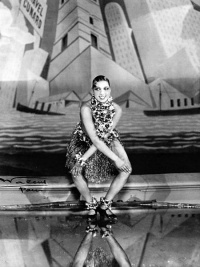Dance
From The Art and Popular Culture Encyclopedia

(Photo by Walery)
|
"I would only believe in a God that knows how to dance" -- Thus Spoke Zarathustra by Nietzsche "Thus the same manifestations are to be observed in each case : cries, songs, music, violent movements, dances, the search for exciteants which raise the vital level, etc."--The Elementary Forms of the Religious Life (1912) by Émile Durkheim, tr. Joseph Swain "The desire to dance is innate; it has exerted a constant influence on music."--Last Night a DJ Saved My Life "The devil seems to be continually busy, inventing new ways to entice young people and adults into all forms of immorality and sin. He has used various forms of dancing very successfully, during the 20th Century. Each decade sees a change in this fad, but it seems that the change never gets better, but invariably gets worse. Various names have been given to the different forms of dancing in this century. We have all heard of the square dance, the round dance, the rock dance and now we hear much about the disco dance. None of these can be recommended for Christians to participate in." --unidentified 1970s Christian source |
.jpg)
.png)
|
Related e |
|
Featured: |
Dance is a type of art that generally involves movement of the body, often rhythmic and to music. It is performed in many cultures as a form of emotional expression, social interaction, or exercise, in a spiritual or performance setting, and is sometimes used to express ideas or tell a story. Dance may also be regarded as a form of nonverbal communication between humans or other animals, as in bee dances and behaviour patterns such as a mating dances.
Definitions of what constitutes dance can depend on social and cultural norms and aesthetic, artistic and moral sensibilities. Definitions may range from functional movement (such as folk dance) to virtuoso techniques such as ballet. In some cases, the motion of ordinarily inanimate objects may be described as dance (the leaves danced in the wind).
There are many styles and genres of dance. African dance is interpretative. Ballet, ballroom and tango are classical dance styles. Square dance and electric slide are forms of step dance, and breakdancing is a type of street dance. Dance can be participatory, social, or performed for an audience. It can also be ceremonial, competitive or erotic. Dance movements may be without significance in themselves, as in ballet or European folk dance, or have a gestural vocabulary or symbolic meaning as in some Asian dances.
Choreography is the art of creating dances. The person who creates (i.e., choreographs) a dance is known as the choreographer.
Dancing and music
Many early forms of music and dance were created and performed together. This paired development has continued through the ages with dance/music forms such as: jig, waltz, tango, disco, salsa, electronica and hip-hop. Some musical genres also have a parallel dance form such as baroque music and baroque dance whereas others developed separately: classical music and classical ballet.
Although dance is often accompanied by music, it can also be presented independently or provide its own accompaniment (tap dance). Dance presented with music may or may not be performed in time to the music depending on the style of dance. Dance performed without music is said to be danced to its own rhythm.
Ballroom dancing is an art although it may incorporates many fitness components using an artistic state of mind.
See also


